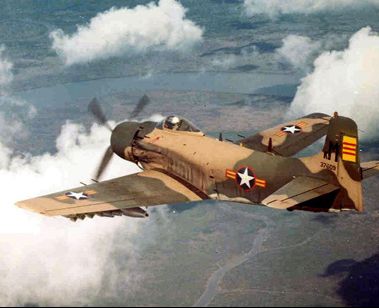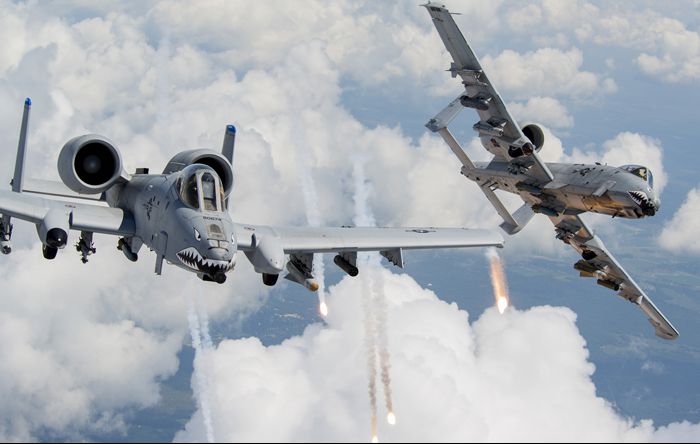Few information released by the Air Force. We know that the squadron was redeployed last week and the "Warthog" has already begun to pound the Islamic state that controls much of Iraq and Syria.
The A-10 is one of the pieces of the mosaic that slowly begins to take shape in the Pentagon's strategy.
The planes are part of the 163rd Expeditionary Fighter Squadron. The unit is also known as "Blacksnakes".
But why was an aircraft designed in the 70 years deployed against the terrorists of Isis?
Simple. The A-10 was designed to survive and pour a hell of fire on the enemy.
Close Air Support
The tactical support is carried out by aircraft with strong abilities to suppress enemy antiaircraft defenses and able to face opposing terrestrial forces in the proximity of those friends. These missions must necessarily be carried out by sturdy, extremely agile low-level aircraft, capable of pouring enormous firepower, collecting the enemy's blows and returning to the base even if heavily damaged. A task carried out even today, since the first flight took place in the 1976, from the A-10: a monstrous machine.
In the forecasts, the F-35 should have replaced it, giving the 'Fairchild' a well-deserved retirement. The latter, however, has been extended since the 1990, when the needs transformed the A-10 from next to the pension to the protagonist.
 The story of close-wing aircraft should reflect. In fact, the role of tactical support has almost always been carried out by aircraft considered obsolete, slow and not in line with the times. Just think about the Douglas A-1 Skyrider, an aircraft entered into service in the 1947 and retired in the 1968. It was slow and obsolete, but very robust. He could collect hundreds of hits from the enemy infantry, be stationed for hours on the operational area, and carry an impressive arsenal through its fourteen sub-wing pylons. It was the perfect aircraft. Same story for the A-10: repeatedly declared ending, but always invoked in the forefront until Usaf is considered the only aircraft dedicated to Close Air Support.
The story of close-wing aircraft should reflect. In fact, the role of tactical support has almost always been carried out by aircraft considered obsolete, slow and not in line with the times. Just think about the Douglas A-1 Skyrider, an aircraft entered into service in the 1947 and retired in the 1968. It was slow and obsolete, but very robust. He could collect hundreds of hits from the enemy infantry, be stationed for hours on the operational area, and carry an impressive arsenal through its fourteen sub-wing pylons. It was the perfect aircraft. Same story for the A-10: repeatedly declared ending, but always invoked in the forefront until Usaf is considered the only aircraft dedicated to Close Air Support.
Now deployed against ISIS. But why?
Meanwhile the context. The infantry support role is a specific task. The fighter flies just a few meters from the ground, so it is within reach of the small and large caliber weapons of the enemy, as well as of the anti-aircraft guns not to mention, finally, the Sam missiles. The aircraft must be able to continue to 'hammer' the enemy by performing multiple passes, staying for a reasonable period on the operational area, protecting its forces.
Usually, the tactical support aircraft, acts in very critical situations, with predominant enemy infantry and is the first to provide support and the last to leave the area (protecting for example a team being recovered). Therefore, armor plating of the aircraft is essential. In close air support, where asymmetric combat reaches its highest peaks, invisibility (to radars), being stealth, holding the most sophisticated avionics, counts for almost nothing, considering that you can fool a missile, but certainly not the 23 mm bullets. And beyond theory, history teaches: the United States has always entrusted close air support to obsolete aircraft compared to the period.
The A-10 has been designed with a single purpose: to survive. It is heavily armored, with armored plates to protect the vital parts of the aircraft. The pilot is protected by a bullet-proof roof and is wrapped in a kind of titanium-mounted "bathtub" weighing approximately 600 kg. The A-10 is designed to withstand cannons of 23 mm and against some of 57 mm. It can fly with a damaged and partially destroyed wing, one engine, one rudder, one wing. It can fly with the damaged hydraulic system, thanks to reserve mechanical controls. Its winged edges curved downward, increase hoist at low speeds. The main wheels of the car protrude from the gondolas when it is retracted: a further survival guarantee even when the cart can not be relaxed.
 The "Warthog" was designed around the seven-barreled GAU-8 Avenger cannon, the most powerful airborne tactical weapon on the planet. It is a gatling type cannon from 30 mm with two firing rates: 2100 or 4200 strokes per minute and can be brought to the maximum firing rate in 0,55 seconds. The ammunition tank carries a maximum of 1350 shots. It is capable of destroying a tank at almost 7 km away.
The "Warthog" was designed around the seven-barreled GAU-8 Avenger cannon, the most powerful airborne tactical weapon on the planet. It is a gatling type cannon from 30 mm with two firing rates: 2100 or 4200 strokes per minute and can be brought to the maximum firing rate in 0,55 seconds. The ammunition tank carries a maximum of 1350 shots. It is capable of destroying a tank at almost 7 km away.
The A-10 has ten sub-wing pylons and is one of the most heavily armed aircraft in the US Air Force. It can carry almost 7 thousand and 500 pounds of weapons. It is powered by two TF34 turbo fans that allow 834 km / h speed and 460 km range. Despite everything, the Air Force is trying to retire the fleet to save money, but from the Pentagon they know that there is no aircraft that can completely replace the "Warthog".
Franco Iacch
(photo: US DoD / US Air Force)













